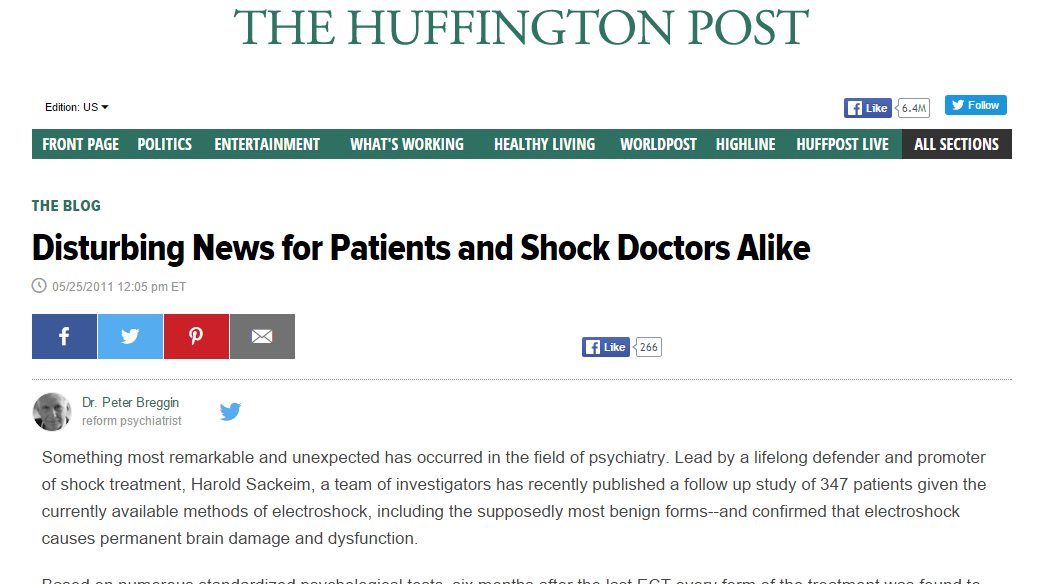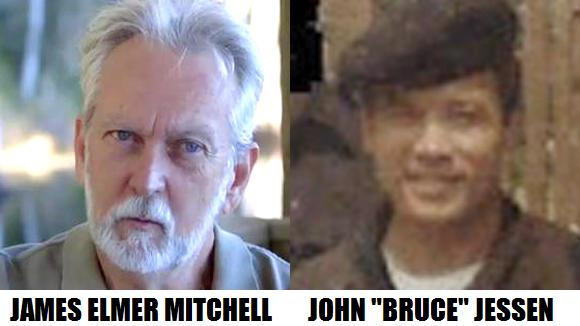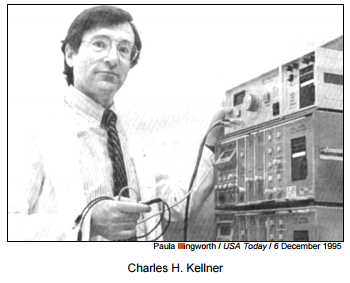
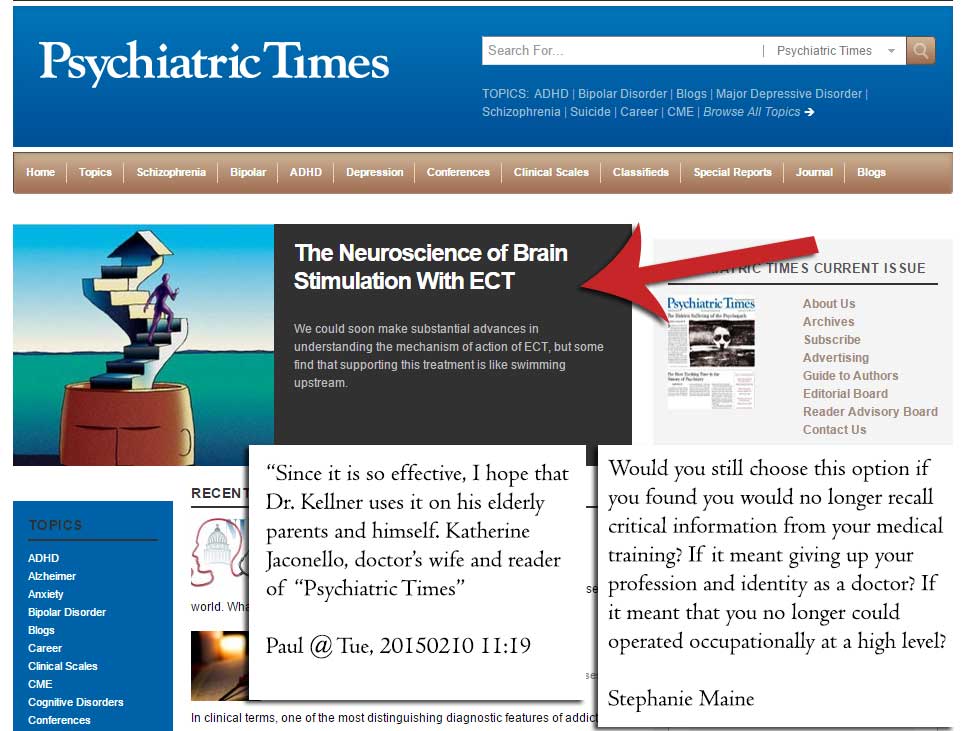
The growing backlash against a treatment which relies on inducing traumatic memory loss, aka brain damage, for effect. That’s 70-500 volts through your brain for up to 8 seconds. See Deleted anti-ECT comments from Psychiatric Times article by Charles Kellner
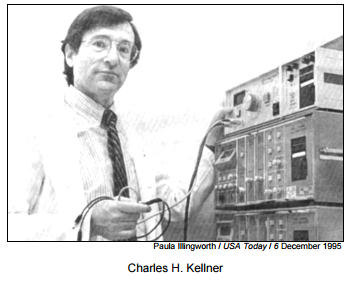
It shall be assumed you have already heard the other side of this argument: ECT is safe, it is a fail-safe, the memory loss is temporary, etc. Here are some accounts to the contrary from people who have actually had it… Excerpt: The Electroshock Quotationary, by Leonard Roy Frank
|
INTRODUCTION: THE ESSENTIALS
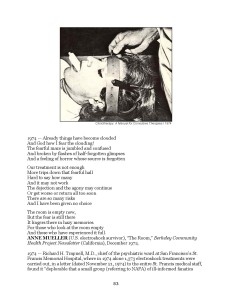
I. THE CONTROVERSY
Electroshock (also known as shock therapy, electroconvulsive treatment, convulsivetherapy, ECT, EST, and ECS) is a psychiatric procedure involving the induction of a grand mal seizure, or convulsion, by passing electricity through the brain. It is the most controversial “treatment” in psychiatry, and perhaps in all of medicine. Proponents call it a safe and highly effective way to address various kinds of “mental illness” and certain medical conditions. Opponents charge that it causes brain damage and is an instrument of social control, sometimes administered by means of coercion or outright force and seldom with genuine informed consent.
II. BACKGROUND
Since 1938, when Ugo Cerletti and Lucio Bini introduced the procedure at the University of Rome, more than six million Americans and millions of others throughout the world have undergone electroshock treatment.
Today, an estimated 100,000 people in the United States undergo ECT every year. Two-thirds are women, and half are elderly. Age is not a disqualifying factor: there are published reports of individuals as young as 34½ months and as old as 102 undergoing the procedure (see in the text Bender’s entry in 1950 and the American Psychiatric Association’s second entry in 1990). A typical electroshock series for a hospitalized “patient” in the United States costs between $50,000 and $75,000. An ECT series may also be administered on an outpatient basis — in a hospital or in a psychiatrist’s office — at considerably less expense: $1,500 to $2,000 per session. Government or private insurance usually covers most, if not all, of the cost. Psychiatrists who specialize in electroshock often earn$300,000 to $500,000 a year, considerably higher than the annual mean income for all psychiatrists ($150,000).The figures in the above two paragraphs suggest that in the United States alone electroshock is a multi-billion-dollar-a-year industry.To reduce the risk of relapse following an electroshock series, psychiatrists often urge patients to pursue continuation (or maintenance) treatment. This generally involves psychiatric drugs and often includes individual electroshocks as well, administered on an outpatient basis at various intervals for six months or longer.
III. DIAGNOSES
The most common indication for electroshock is a diagnosis of clinical, or severe,depression. An ECT series for depression typically consists of 6 to 12 sessions. People diagnosed with schizophrenia or bipolar disorder (manic depression) may also be subjected to electroshock, but this is less common; for such patients, a series of 15 to 25 sessions is standard. ECT is usually administered in the early morning, three times a week (Mondays, Wednesdays, and Fridays). Electroshock has also been administered to people with the following psychiatric diagnoses: alcoholism, anorexia, anxiety disorder, catatonia, drug withdrawal syndrome, homosexuality (no longer a psychiatric diagnosis), hysteria (ditto), narcotic addiction, neurosis, obsessive-compulsive disorder, personality disorder, postpartum depression, postpartum psychosis, psychosomatic disorder, pseudodementia, psychosis, and substance abuse. In addition, ECT has been used to treat these medical conditions: Alzheimer’s disease, backache, acute and chronic pain, delirium tremens, dementia,epilepsy, mental retardation, neuroleptic malignant syndrome, Parkinson’s disease, and psoriasis. For.For persons said to be suicidal or in a state of depletion from lack of food (inanition),electroshock is frequently the treatment of choice. For most psychiatric diagnoses,however, it is the treatment of next resort (after one or more unsuccessful trials with a psychiatric drug or combination of psychiatric drugs).
IV. METHOD OF ADMINISTRATION
Prior to the start of an electroshock series, the patient is given a psychiatric evaluation and a physical examination. A consent form signed by the patient, a family member, or a state-appointed guardian or conservator is almost always obtained after a psychiatrist has explained to the designated signer the nature and effects of the procedure, the manner of its administration, and why it has been deemed necessary. Some states require a confirming opinion by a second physician. Some also require a judicial hearing if the patient’s legal capacity to give or withhold consent is questionable, or if the patient withholds consent. A routine is followed for each session. The patient is asked to avoid food and drink for 8 to 12 hours beforehand. To prevent oral intake, each patient is usually kept under direct staff observation. During this period, tranquilizers or sedatives may be used to reduce the patient’s fear of and/or resistance to electroshock. Bladder and bowels are emptied just before the session, and dentures, eyeglasses hairpins, earrings, and the like are removed. About 30 minutes beforehand, a conventional preanesthetic medication called atropineis administered to dry secretions in the mouth and air passages, thus reducing the risk of suffocation and other complications of swallowing one’s own saliva.
UNITED PRESS INTERNATIONAL“CIA Once Tried Electroshock, Though It Created ‘Vegetables,’” San Francisco Examiner, 8 January 1979. The following excerpts are from a copy of an anonymous CIA agent’s memo cited in the article: “…All others present, discussed the use of electroshock at considerable length and it was [redacted] opinion that an individual could gradually be reduced through the use of electro-shock treatment to the vegetable level. “‘Artichoke’ — [redacted]….
|
Shortly afterward, the patient is taken to the treatment room and put on a bed, padded table, or gurney. Electrolyte jelly is applied to the two areas of the head, usually the temporal areas, where the electrodes are to be placed. The jelly increases conductivity and prevents burns. An intravenous line is started, and sensors are placed on the head and chest to monitor brain and heart activity. A cuff is wrapped around the patient’supper arm to record blood pressure.The patient is then anesthetized for 10 to 15 minutes with a short-acting barbiturate,commonly Brevital (methohexital). Once the patient is unconscious, the muscle relaxant Anectine (succinylcholine) is injected to reduce the risk of fractures, joint dislocations,and damage to skeletal muscle, tendons, and ligaments, which were very common before this modification became routine during the 1950s. Anectine causes an almost complete paralysis of the body, including the respiratory system, so that the patient must be supplied oxygen through a mask (oxygenation) until the Anectine wears off and the patient is able to resume breathing on his or her own.The anesthetic is not used to spare the patient pain because the shock itself, if strong enough, produces instant unconsciousness and is therefore painless. Instead, the anesthetic’s purpose is to eliminate the sensation of suffocation that the patient, without an anesthetic, would experience as the muscle relaxant gradually took effect. ECT without anesthetics and muscle relaxants is now referred to as unmodified or classical ECT; the version with anesthetics, muscle relaxants (also called muscle paralyzers), oxygenation, and monitoring is called modified ECT. Unmodified ECT is now rare in the United States and Europe but is still common in developing countries because of its lower cost.Just before the convulsion, a rubber gag is inserted in the patient’s mouth to prevent broken teeth and tongue-biting. Two electrodes wired to the shock machine are then positioned on the head and may be held in place by an elastic headband. The preparations having been completed, the psychiatrist presses a button on the shock machine, releasing 70 to 500 volts (or more) of electricity for .02 second to 8 seconds. The electric current penetrates the patient’s skull and passes through the brain, causing a grand mal convulsion that lasts for 30 seconds to a minute and sometimes longer.The patient then is taken to the recovery room in a comatose state, from which she or he usually revives in 10 to 20 minutes. Ordinarily, the patient is able to leave the recovery room 30 to 60 minutes later.
V. EFFECTS
Once conscious, the patient experiences one or more of the following adverse effects: headache, dizziness, nausea, confusion, disorientation (not knowing who or where one is or what time or day it is), muscle ache and soreness, physical weakness, memory loss,euphoria, increased or irregular heartbeat (especially among the elderly), brief or duration, number, and spacing of the individual convulsive procedures, determine the severity and persistence of these effects.
Electroshock can also be fatal. Estimates of ECT-related death rates vary widely.
The lower estimates include:
- 1 in 10,000 (see in the text Boodman’s first entry in 1996)
- 1 in 1,000 (Impastato’s first entry in 1957)
- 1 in 200, among the elderly, over 60 (Impastato’s in 1957)
Higher estimates include:
- 1 in 102 (see in the text Martin’s entry in 1949)
- 1 in 95 (Boodman’s first entry in 1996)
- 1 in 92 (Freeman and Kendell’s entry in 1976)
- 1 in 89 (Sagebiel’s in 1961)
- 1 in 69 (Gralnick’s in 1946)
- 1 in 63, among a group undergoing intensive ECT (Perry’s in 1963-1979)
- 1 in 38 (Ehrenberg’s in 1955)
- 1 in 30 (Kurland’s in 1959)
- 1 in 9, among a group undergoing intensive ECT (Weil’s in 1949)
- 1 in 4, among the very elderly, over 80 (Kroessler and Fogel’s in 1974-1986)
The reasons for the difficulty in estimating ECT-related deaths include the following:
- There is no central tracking of ECT-related deaths.
- Some psychiatrists and hospitals underreport the number of ECT-related deaths.
- Some psychiatrists and pathologists do not recognize deaths occurring during or soon after ECT as ECT-related.
- Families often refuse to authorize autopsies of relatives who have died during or soon after ECT.
- Professional journals are disinclined to publish reports or studies of ECT-related deaths. Not since 1957 has any journal published a large-scale study of ECT-related deaths (see in the text Impastato’s first entry in 1957).
- It is difficult to determine with certainty, or near certainty, that ECT was the cause of a patient’s death because multiple causes are often involved.
- Deciding whether or not a patient’s death is ECT-related is difficult to establish because there is no accepted time interval between a death and the last electroshock he or she received. For example, is it an ECT-related death only if the patient dies within a few minutes of undergoing ECT or may the interval be a specific number of hours, days, or weeks up to a year?
VI. DOES ELECTROSHOCK WORK?
Opponents charge that ECT is demonstrably harmful and has not been proven effective(even by psychiatric standards) for any more than a month or two. However, some patients who have undergone electroshock, their families, and psychiatrists assert that the procedure has been helpful. In evaluating their reports, opponents urge consideration of the following:
- Patients may feel better because of the well-known placebo effect. Any treatment offered by a doctor, along with the suggestion that it will work, may have the effect of making a patient feel better, at least for a while.
- Patients may say they feel better (even when they don’t) for a variety of reasons: because it’s expected of them, because they want to please their psychiatrists or relatives, or because they fear that speaking truthfully would result in further ECT or other sanctions.
- Due to ECT-induced memory loss, patients may forget what had been bothering them; as a consequence, they may feel less troubled and complain less to others.
- Due to ECT-induced memory loss, patients may forget their ideas, beliefs, and forms of conduct that others had found objectionable, including resistance to being confined in a psychiatric facility and subjected to electroshock treatment.This phenomenon may be called the brainwashing effect.
- Family, friends, psychiatrists, and hospital staff may feel sympathy for ECT patients and give them more consideration and better care.
- Patients who believe the claims of psychiatrists and agree to undergo ECT may give up so much self-respect, health, memory, intelligence, money, skills, or faith that they refuse admit to themselves or others they are worse off after ECT.
- ECT-induced brain damage may be so severe that patients are unaware of their losses.
- ECT-induced brain damage may result in a brief period of euphoria during which the depression seems to lift, so for a time patients may indeed feel better.
- ECT patients typically become dependent on others and more docile, more cooperative, and easier to get along with as they recover from the treatment.
- Because ECT deadens the emotions, patients whose everyday lives are filled with tension, anger, sadness, and misery may experience temporary relief.
VII. WELL-KNOWN ELECTROSHOCK PATIENTS
Some of the better-known people who have undergone electroshock treatment include French philosopher Louis Althusser, French playwright and actor Antonin Artaud, actor Clara Bow, writer and poet Richard Brautigan, television personality Dick Cavett, Kitty Dukakis (Massachusetts governor Michael Dukakis’s wife), Missouri senator and(briefly) 1972 Democratic Party vice presidential nominee Thomas Eagleton, writer Ralph Ellison, actor Frances Farmer, New Zealand writer Janet Frame, singer Connie Francis, singer and actor Judy Garland, Naomi Ginsberg (Allen Ginsberg’s mother), Australian pianist David Helfgott, writer Ernest Hemingway, Russian-born U.S. pianist Vladimir Horowitz, Irish poet Pat Ingoldsby, poet Bob Kaufman, musician Roland Kohloff, Olga Koklova (Pablo Picasso’s first wife), writer Seymour Krim, British actor Vivien Leigh, pianist and actor Oscar Levant, poet Robert Lowell, British humorist Spike Milligan, composer Paul Moravec, physician and writer Sherwin Nuland, actor JenniferO’Neill, English writer and illustrator Mervyn Peake, baseball player Jimmy Pearsall, writer Robert Pirsig, poet Sylvia Plath, composer Cole Porter, poet and lyricist Dory Previn, songwriter and performer Lou Reed, singer/actor and human rights leader Paul Robeson, French fashion designer Yves Saint-Laurent, writer Andrew Solomon, writer William Styron, actor Gene Tierney, songwriter and performer Townes Van Zandt,physician Mark Vonnegut (Kurt Vonnegut’s son), poet John Wieners, Rose Williams(Tennessee Williams’s sister), British writer Simon Winchester, CIA official Frank Wisner, Australian singer Stevie Wright, and singer Tammy Wynette.
VIII. OVERVIEW
While media reports suggest that electroshock use in the United States is increasing, there is a growing grassroots movement demanding that the procedure be abandoned or abolished.
SIGMUND FREUD
(Austrian neurologist and founder of psychoanalysis, a form of psychotherapy),
Studies in Hysteria, ch. 2, sect. 5, 1893-1895, tr. James and AlixStrachey, 1955. Thirty years later, Freud commented on this practice, “My knowledge of electrotherapy was derived from W. Erb’s textbook, which provided detailed instructions for the treatment of all the symptoms of nervous diseases. Unluckily, I was soon driven to see that following these instructions was of no help whatever and that what I had taken for an epitome of exact observations was merely the construction of fantasy…. The successes of electric treatment in nervous disorder (in so far as there were any) were the effect of suggestion on the part of the physician” (An Autobiographical Study, ch. 1, 1925, tr. James Strachey, 1927).
Deleted anti-ECT comments from Psychiatric Times article by Charles Kellner:
In 1995 a study found that from 5–40% of psychiatric patients have medical ailments that would adequately explain their symptoms. The next year, in 1996, Sydney Walker III, M.D., a psychiatrist, in his book, A Dose of Sanity, claimed studies have shown that from 41% to 75% of individuals are initially misdiagnosed, often due to overlooked treatable conditions. In 2009, it was found that up to 25% of mental health patients have medical conditions that exacerbate psychiatric symptoms.
There are 4 reasons in the medical model for brain dysfunction 1: Anatomical abnormalities or damage. 2: Lack of oxygen or glucose 3: Electrolyte imbalance 4: Neurotransmitter deregulation: the imbalance of brain chemistry. (Biology and Human Behavior: The Neurological Origins of Individuality, Professor Robert Sapolsky, Stanford University, The Great Courses, The Teaching Company © 1996)
Trauma can result in shrinkage of the hippocampus which is adjacent to the amygdala, and can be considered the emotional center of the brain. This shrinkage affects the communication between areas of the brain and is responsible for heightened fear and anger responses. (Does Stress Damage the Brain, by J. Douglas Bremmer MD, Biologivcal Psychiatry 1999; 45:797805; Traumatic Amnesia, Repression, and Hippocampus Injury due to Emotional Stress, Cortisosteroids and Enkephalins by R. Joseph, Ph.D. Child Psychiatry Hum Dev. 1998 Winter;29(2):16985) This means trauma would fit into category 1. Several proven nondrug methodologies are available to treat trauma, including Somatic Experiencing (www.traumahealing.com), Eye Movement Desensitization and Reprocessing (www.emdr.com), and Tension & Trauma Releasing Exercises (www.traumaprevention.com or the book The Revolutionary Trauma Release Process by David Berceli, Ph.D.) Then there is magnesium deficiency which falls into category 3, magnesium being an electrolyte, as well as a key component of serotonin. “…Magnesium is essential in regulating central nervous system excitability thus magnesium deficiency may cause aggressive behavior, depression, or suicide. Magnesium calms the brain and people do not need to become severely deficient in magnesium for the brain to become hyperactive… a marginal magnesium intake overexcites the brain’s neurons and results in less coherence – creating cacophony rather than symphony – according to electroencephalogram (EEG) measurements. (Transdermal Magnesium Therapy ©2007 by Mark Sircus, Ac., O.M.D pg.5)
With such high percentages of people being misdiagnosed and other nonharmful treatments being overlooked, I fail to see how ECT can be endorsed by anyone.
Robert @ Tue, 20150210 12:20
Dr. Kellner, may I inquire as to your personal experience with ECT? Have you undergone the procedure? I have. It was stopped after six treatments because the psychiatrist noted the severe mental impairment it was having. No one can adequately explain the precise mechanisms that ECT “corrects” but I assure you it IS NOT a cure all for mental health presentations. Adverse cognitive effects? They are legion. I always ask my physician friends if they willingly would submit to ECT as a treatment for depression, or other stated mental incapacity, I always receive the answer, “only if I were immediately suicidaltoo many cognitive impairments, my skills as a physician would diminish, weighed against the benefit.” Submit to a full course of treatment with ECT, then come back and sing it’s praises Dr. Kellner. Speak personally to its wondrous benefits. I bet your malpractice insurance will skyrocket the minute your insurer discovers you were subjected to ECT.
Timothy @ Tue, 20150210 12:04
“Ects is currently the most lucrative outlet for psychiatrists and all others involved. Between the bill for Dr.kellner, the antethiesiogist (OK, I can’t spell), and the room the hospital bills you for, you’re looking at a ton of money! But, none of that makes a difference to me. I trusted Charles Kellner with my life, and he erased my memory leaveing me with nothing, more dismal than I was in the first place. This letter is direct evidence of just how much I have lost, I was an English major. Now, I write like I’ve never been to college. After graduating from Presbyterian College with an English degree and history minor, I went on to culinary school at Johnson and Whales. Having gone through any education is , at this point, completely useless. While in the care of “doctor Kellner,” I was shipped into ECTs. Ten did not work, and neither did fifteen, and seventeen times later I was supposed to be cured. Guess what? I was not cured.” (from RateMDs, a victim’s reponse to Dr. Kellner)
Paul @ Tue, 20150210 11:32
I’ll be happy to give up ECT as soon as they find a treatment that is equally effective, reliable, safe, fast acting and well tolerated. Until then I’ll be doing it every Monday, Wednesday and Friday and not feeling the least bit bad about it.
John @ Tue, 20150210 11:28
If you call brain damage, treatment, perhaps you should review your concept of man. Quit ECT and find a functional medical doctor or at least read, “The Disease Delusion” by nutritional biochemist, Jeffrey Bland…before it is too late! Katherine Jaconello
Paul @ Tue, 20150210 11:40
Since it is so effective, I hope that Dr. Kellner uses it on his elderly parents and himself. Katherine Jaconello, doctor’s wife and reader of “Psychiatric Times”
Paul @ Tue, 20150210 11:19
I’m not clear on the tone here, but most of the patients I see who respond best to ECT are elderly. I think being elderly should put ECT even higher on a patient’s list of treatment options. I doubt any doctor uses ECT on themselves because it is too hard to push the button when you are under general anesthesia and paralysed, but if I ever get a crippling or psychotic depression I would want one of my colleagues to give me ECT right away before I killed myself.
John @ Tue, 20150210 11:30
The author relies on the old trope that the reluctance of patients to consider ECT is rooted in poor publicity or perhaps the length of time that a treatment has been available; I do not believe that is as much the case as physicians wish to believe. Physicians do seem to be more reluctant to consider the notion that patients might have formed more reasoned concerns about a treatment, and may evaluate its efficacy/risk ratio quite differently.
If anything, a treatment with a longer track record generally means a treatment where more is known…and that is usually a valuable consideration. In this case it tends to lend to increased concern as there are still strong concerns about the impact on memory, a noted tendency of patients to report less positive outcomes over time, and very little understanding of the mechanisms of treatment itself after so many years of administration. With the studies noted by the author, it is clear organic changes are occurring; however, it is still not well understood which of those changes may be associated with a positive effect and which of those changes may be indicators of negative effects.
John, I have suffered from multiple instances of crippling depression. I am rarely not impacted by depression in fact. I would not consider ECT at the present time, nor do I feel I would in the future given present data. This is not due to hysterical fear, or love of my rather unpleasant symptoms, or a lack of ability to parse the data; it is due to some very real concerns about the affect on memory and the impact of treatment on my appreciation of life and self.
There are not many things that really help in my case. I do find that in managing my depression that I rely on small and unexpected things, and memory and concentration are key to me in attempting to use coping strategies. They are also the fundamental basis for rebutting the internal negativity and despair that is the black pit I fall into. Some people seem to focus on large, demonstrable life accomplishments, religion/philosophy, or their family…and all of that can be helpful to some. I find that when I am truly feeling ill, that these are hard to capitalize on. What does help are the small things. Tiny moments. Remembering what my daughter smelled like when she was first born. The sound of the oboe in a Mozart concerto. Standing in the sun in Red Rock country. Snippets. Moments. My depression cannot corrupt these. They are my weapons in the fight.
Memory and experiences make us who we are. Which of those things would we choose to lose during a time where so much else seems lost? And the kicker, we have no idea which things we might lose…nor does anyone else! Which part of our past would have to be narrated back to us as a third party experience? Or not recalled at all as it was unique to us alone?
Its a hefty price for a course of treatments that may bring relief, or not, or do so temporarily if it does at all.
As to the elderly, I would have concerns about using that much general anesthesia on a serial basis. I’d also have concerns that perhaps they are more liable to report positively in the hopes of not disrespecting their doctor or perhaps in the hope the treatment may stop and you’ll go away if it “works”. My personal view is that the elderly are overly vulnerable to the wrong kinds of intervention
for their depression. How much are they “treated” for what may be a very reasonable response to poor living conditions, emotional abandonment, loss, callous caretakers, and a lack of stimulation and worth?Does response mean they no longer complain? They score better on an assessment scale? Are they docile for their caretakers?
Or does it mean they are enjoying life, engaged and participating?
John, if you ever do experience a crippling depression (which I fervently hope that you never do!), ECT isn’t the only option to suicide. I am very worried that you see it in those terms at all.
Would you still choose this option if you found you would no longer recall critical information from your medical training? If it meant giving up your profession and identity as a doctor? If it meant that you no longer could operated occupationally at a high level?
A great deal about the acceptability of a treatment has to do with the patient’s expectations of life. We have to respect what makes life valuable to us.
Stephanie Maine
Stephanie @ Tue, 20150210 13:17
Beautifully stated Stephanie. My greatest loss was my memory of so many things that people remind me of daily. Friends and colleagues remark, “remember being awarded professor of the year?” Sadly, after ECT I do not have a cogent memory, just jagged fragments. For those who
ECT has been recommended, please seek another form of treatment. My only hope would be that ECT and it’s adherents will be looked upon as a crude treatment by physicians who experimented on human life without the slightest clue as to the specific machinations or clinical outcomes, other than a perverse lab rat interest. Medical ethics? not so much.
When Greed Trumps Ethics
Doing Harm: Health Professionals Central Role in the CIA Torture Program
Mental Health Professionals are just as susceptible to greed, peer pressure and conformity as anyone else, even in regards to participating in, and creating methods of torture. Witness the role of the psychologists below. That said, you may hear a lot of unusual arguments favoring ECT, including the latest from USC arguing it improves memory!

